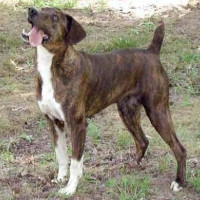Appearance of the Treeing Cur
|
| The Treeing Cur is one of the most varied dogs in terms of size and color among the Cur breeds; all colors are accepted, with the exception of albinism, they can measure between 46 and 61 centimeters at the shoulder and their weight can vary from a modest 13.5 kilos to a solid 27 kilos. Their backs are strong, slightly longer than their waists, and they are endowed with a generous amount of muscle. The head is generally quite broad and flat, tapering to a muzzle slightly shorter than the length of the skull, with a square black nose that can be black or pink. The Treeing Cur has medium to long rounded ears that fall close to the cheeks, and its eyes are set wide apart; although brown is the preferred color, it can also be green, yellow or blue. |
Temperament of the Treeing Cur
|
| These dogs are generally alert, intelligent and athletic, but while they have a strong desire to please their master, they also have a very strong will; after all, they were bred to be able and willing to protect their families from large predators like mountain lions and bears, as well as to hunt brutal wild boars, and to manage livestock like the Texas Longhorn. Although interactions between dogs and young children always require supervision, this breed is generally friendly and affectionate towards family members of all ages, and with proper socialization, is also generally pleasant towards other dogs. However, it does require firm training to prevent it from becoming too protective of its home and family. They are naturally skilful hunters, using all their senses when stalking prey, although some follow their game in silence while others bark when in pursuit. |
Needs and activities of the Treeing Cur
|
| These are extremely athletic, active dogs bred for power and stamina, and they tend to need plenty of exercise to maintain their prowess, at least an hour to an hour and a half of vigorous exercise a day. It's also important to remember that these dogs are as mentally active as they are physically, and that mental stimulation is as essential as physical activity. Alternative activities such as hunting or herding competitions, agility training and even canine freestyle dancing can help meet these needs. While these dogs make exceptional rural companions, they are generally not at home in smaller, apartment-like environments. |
Maintenance of the Treeing Cur
|
| These dogs have very low grooming requirements, due to their easy-care, single-layer coat. This dog should only be bathed when absolutely necessary, as frequent bathing can lead to skin dryness and irritation. Brushing is generally only necessary once or twice a week, to control shedding and give the coat a glossy sheen. Nail care involves monthly trimming. Exorbitant dental expenses can be avoided by brushing teeth three times a week. Dogs with floppy ears, such as the tree-dwelling Cur, are somewhat prone to ear infections. To avoid this, many Cur owners will trim the excess hair inside the ear canal and keep the ears clean and dry. |







 English (United Kingdom)
English (United Kingdom)